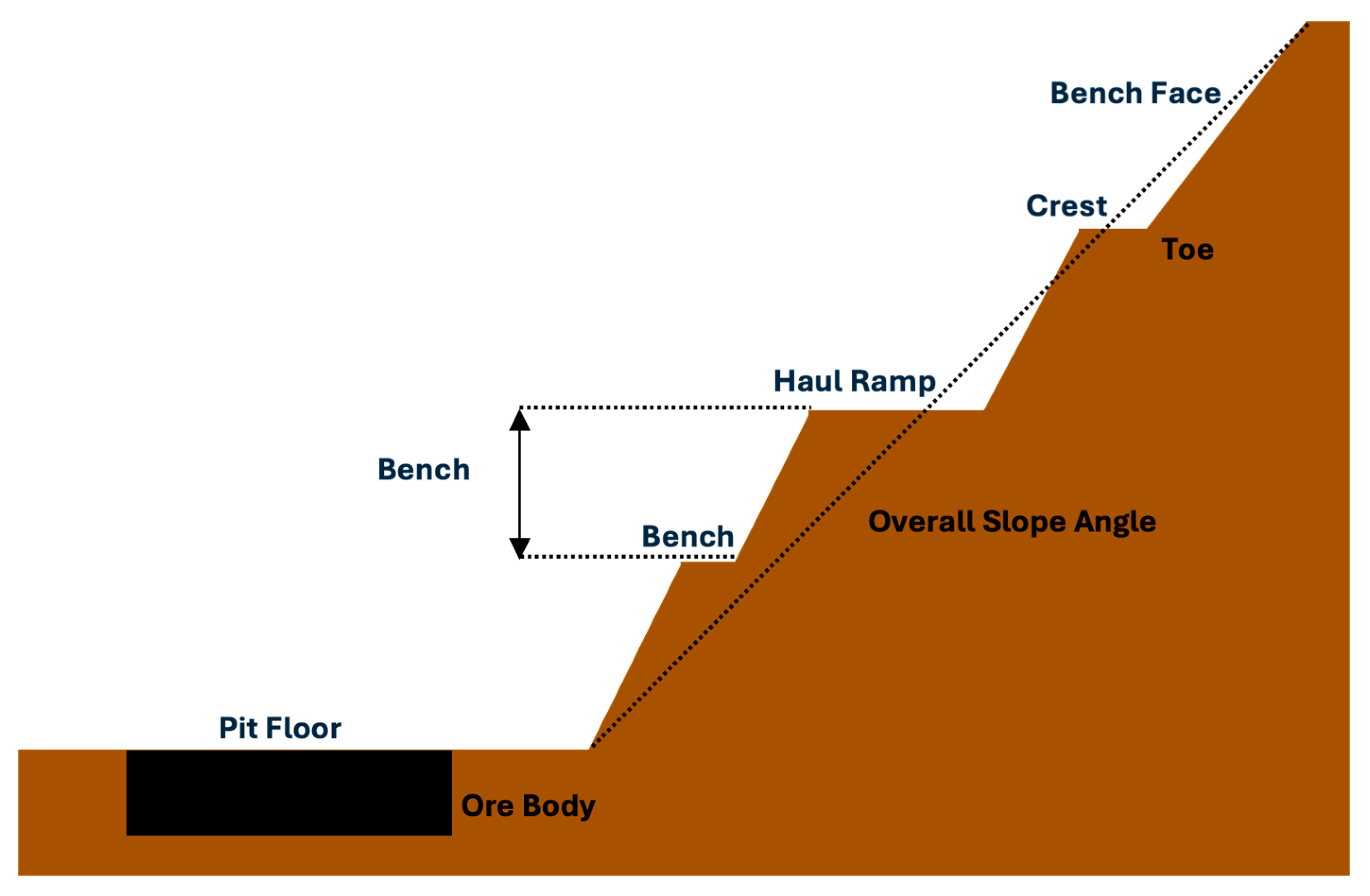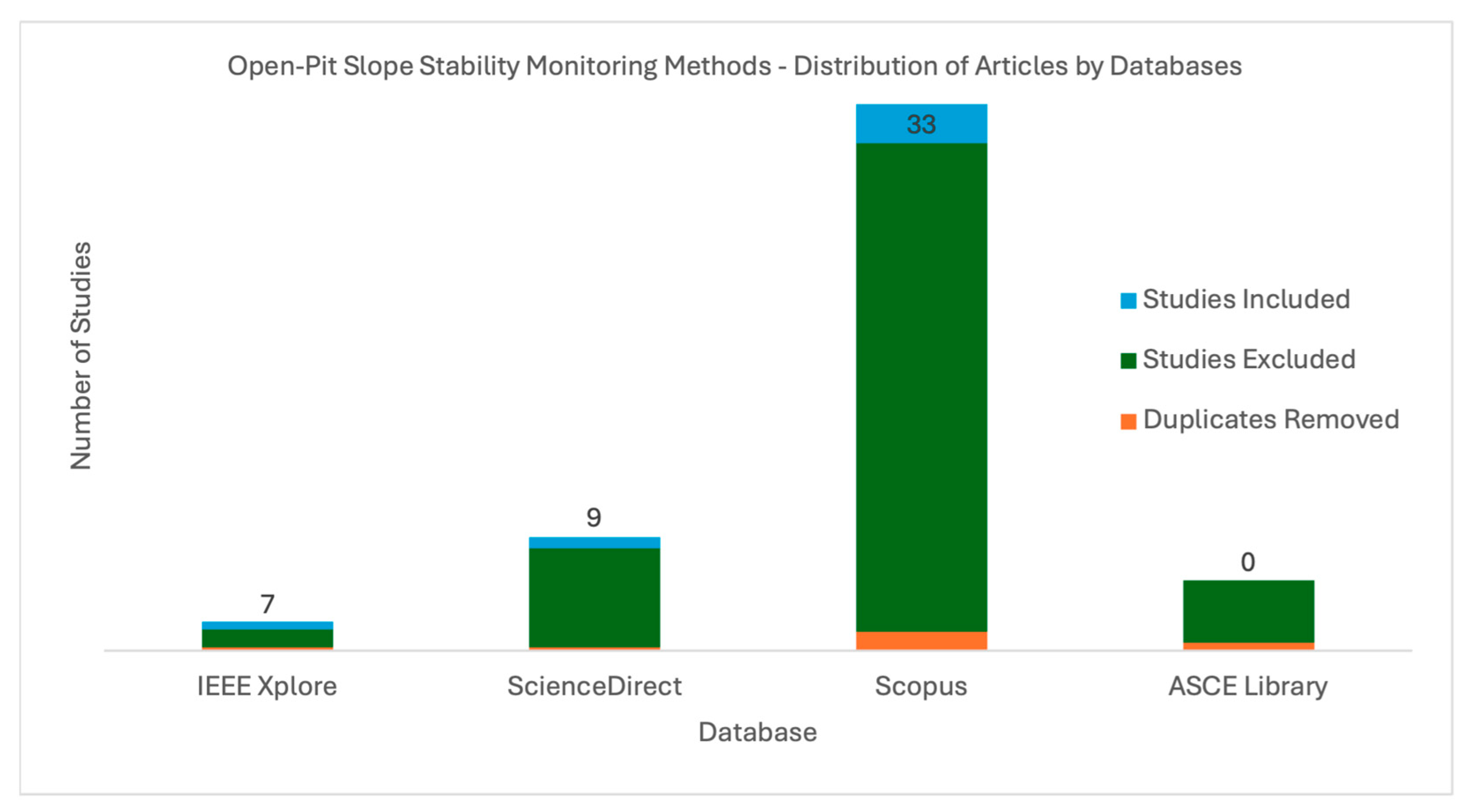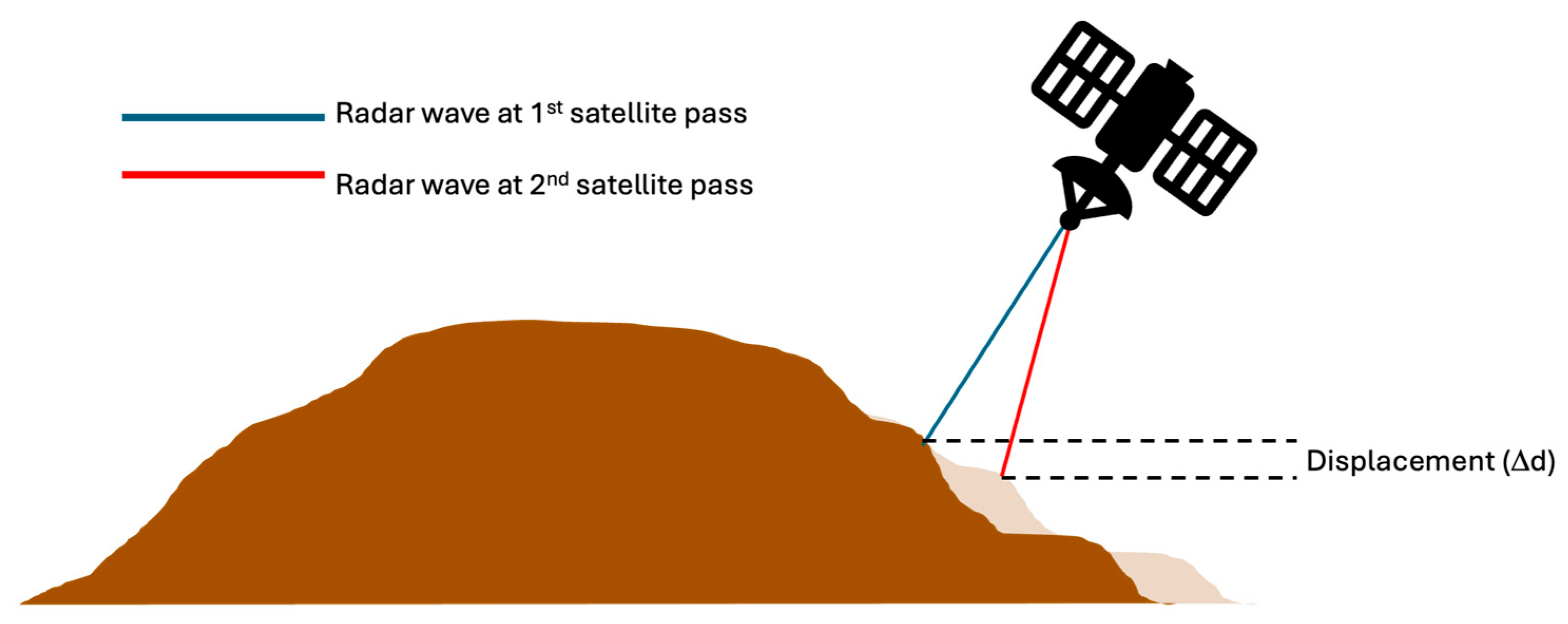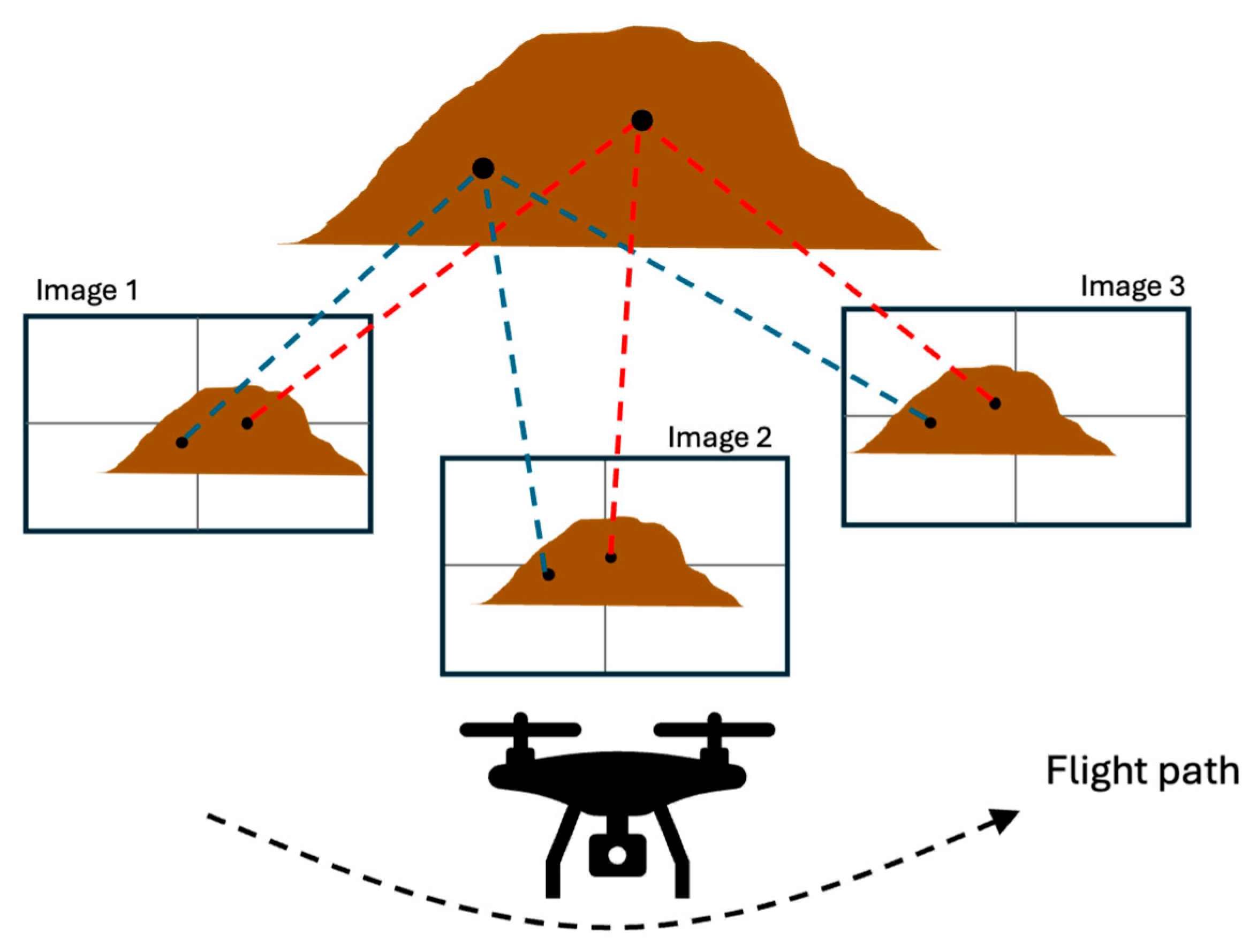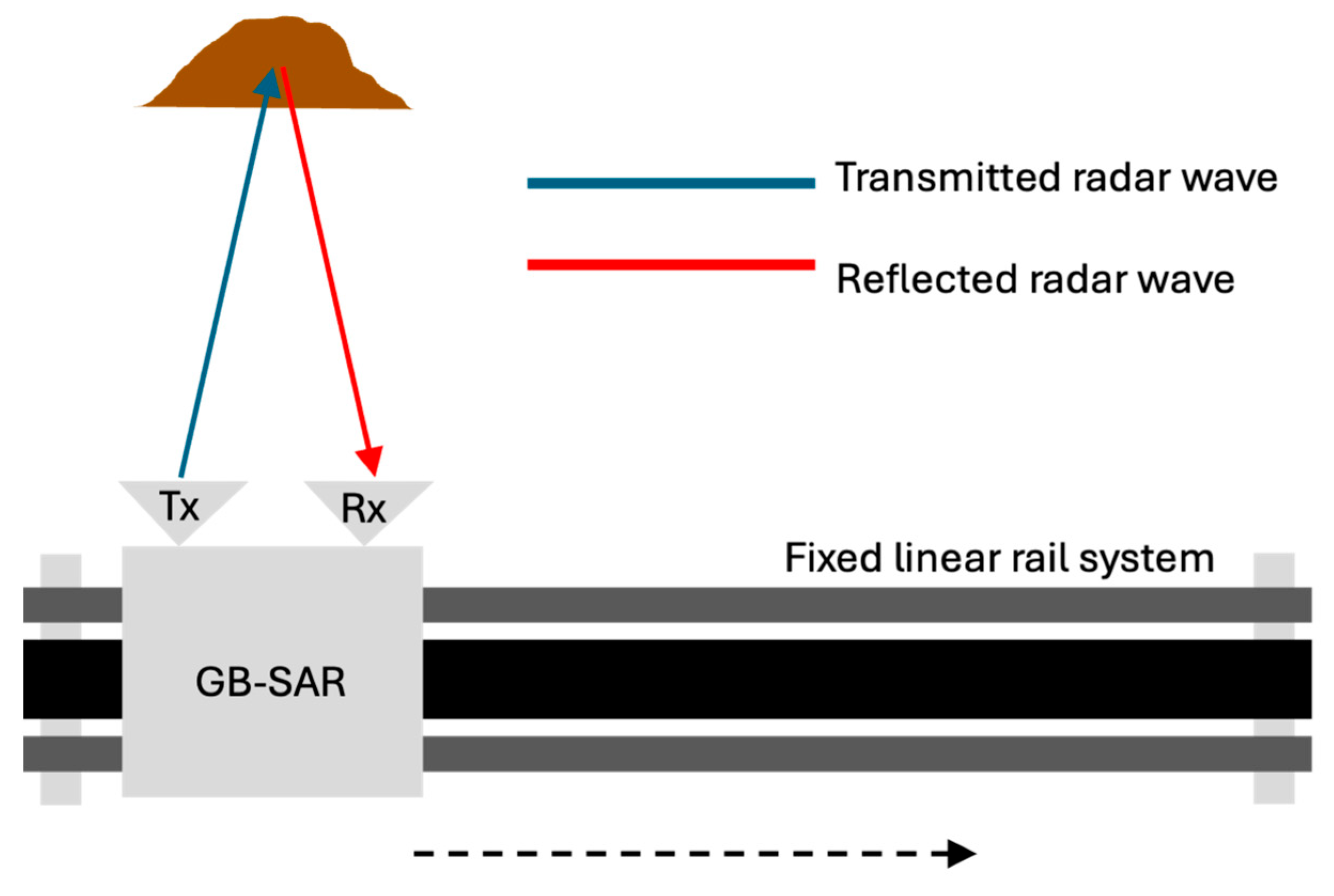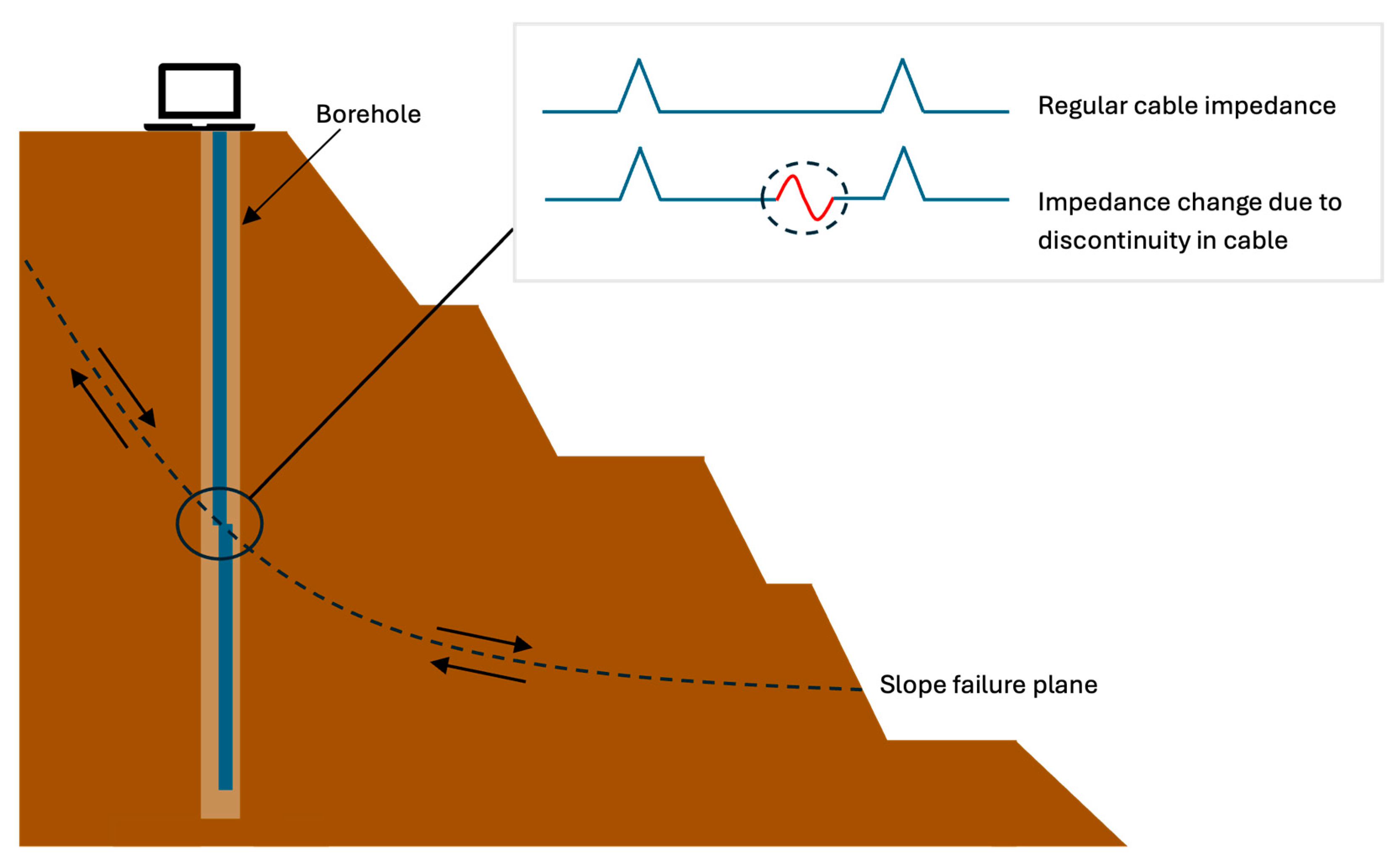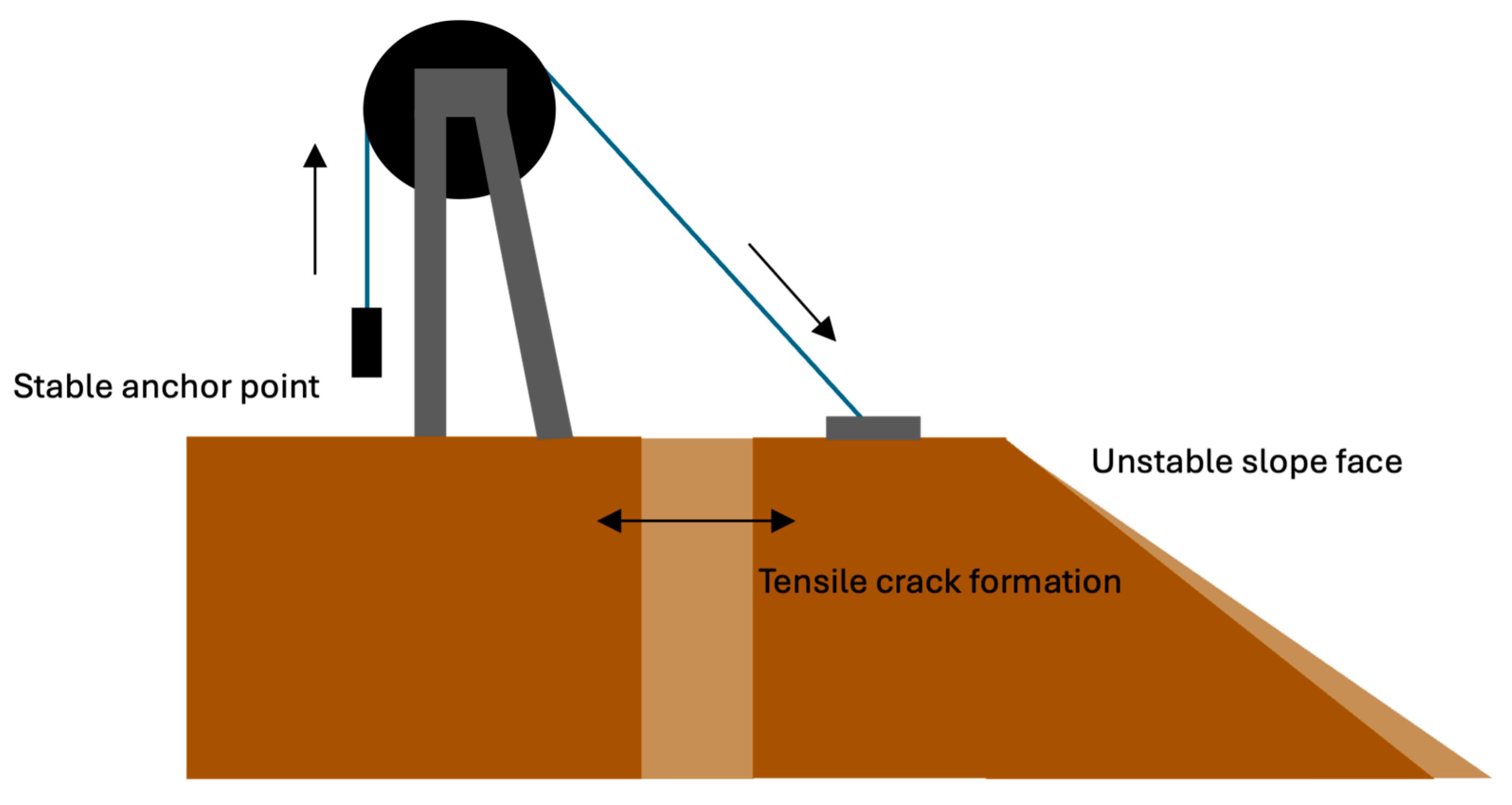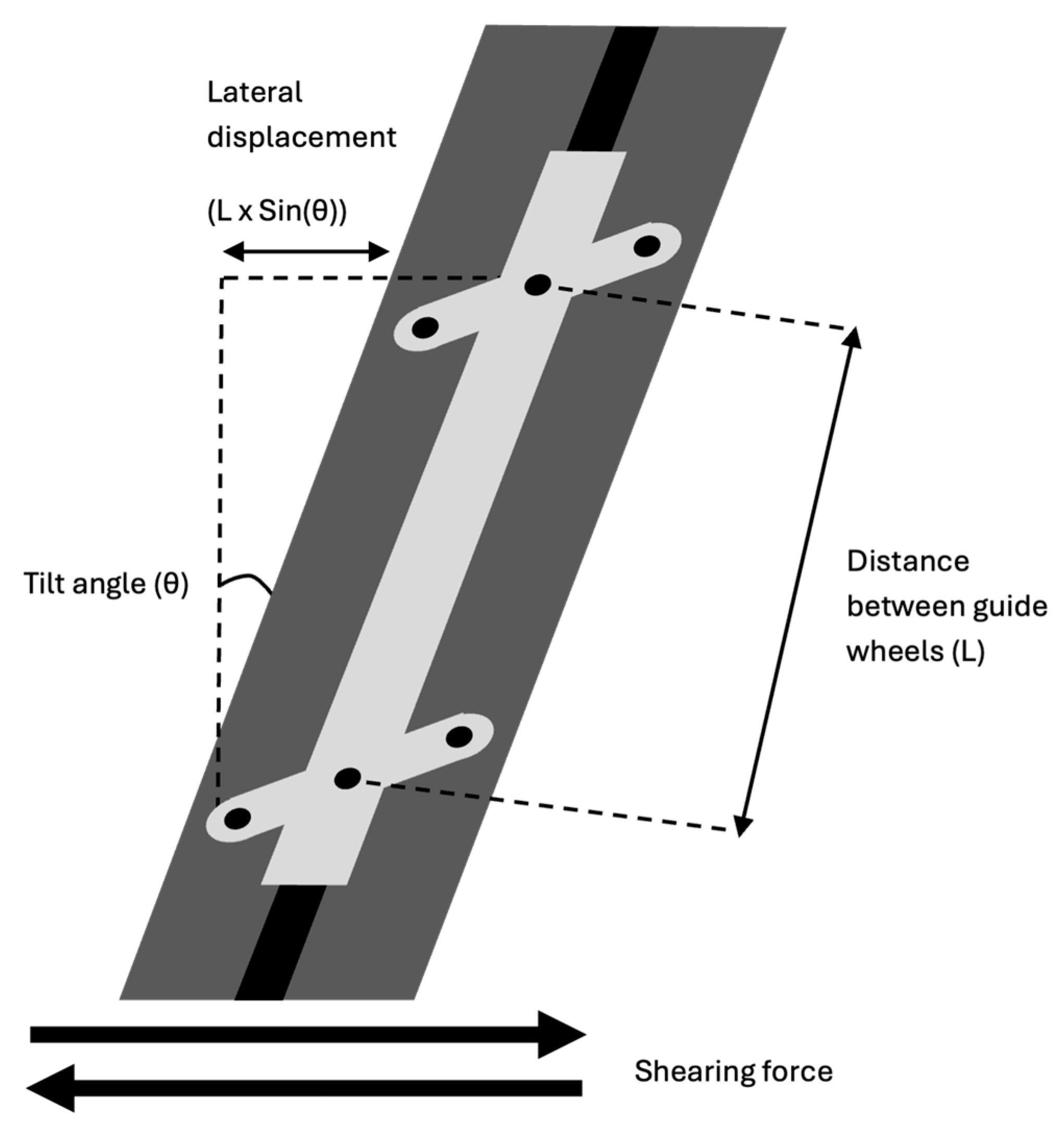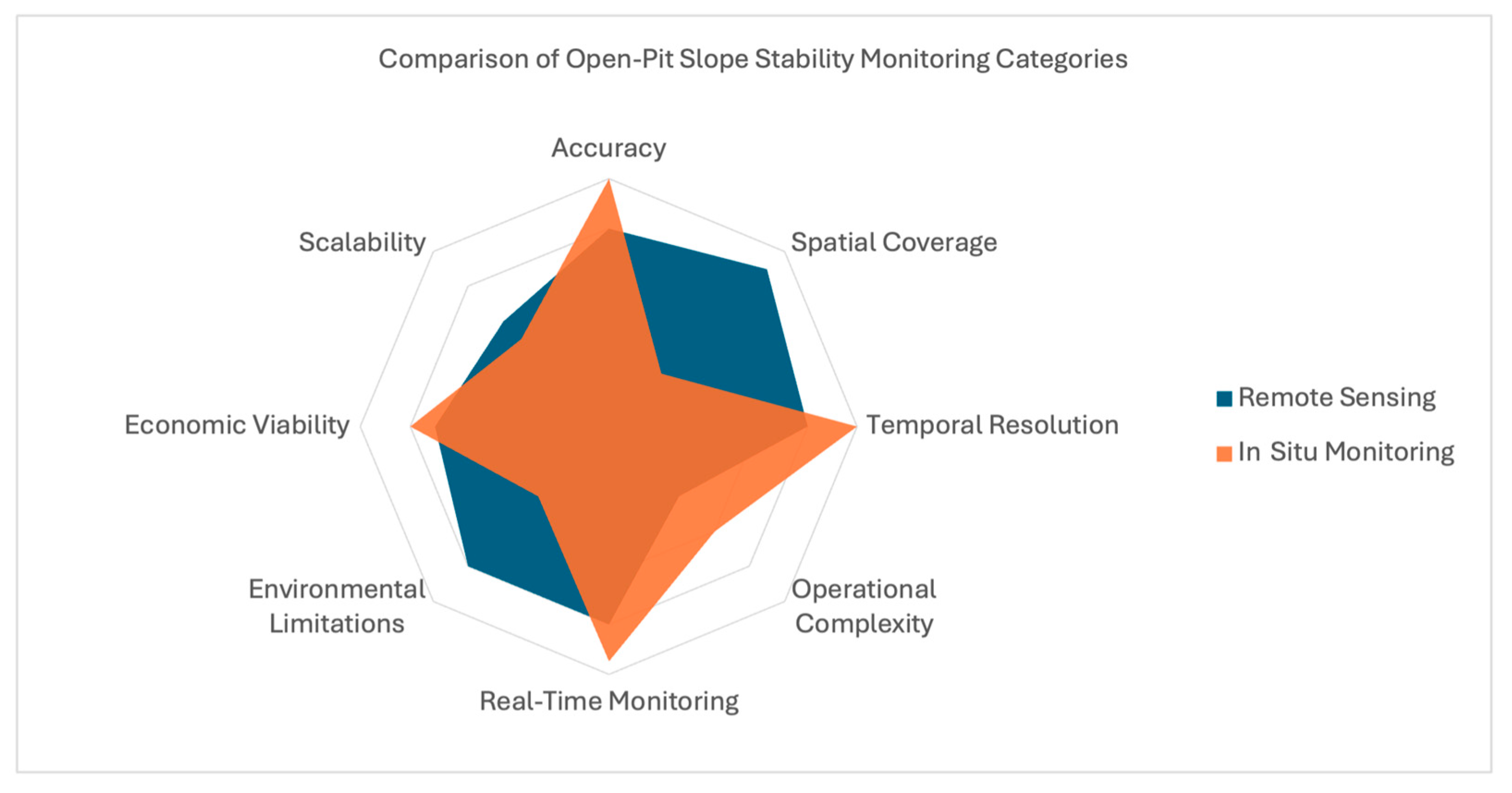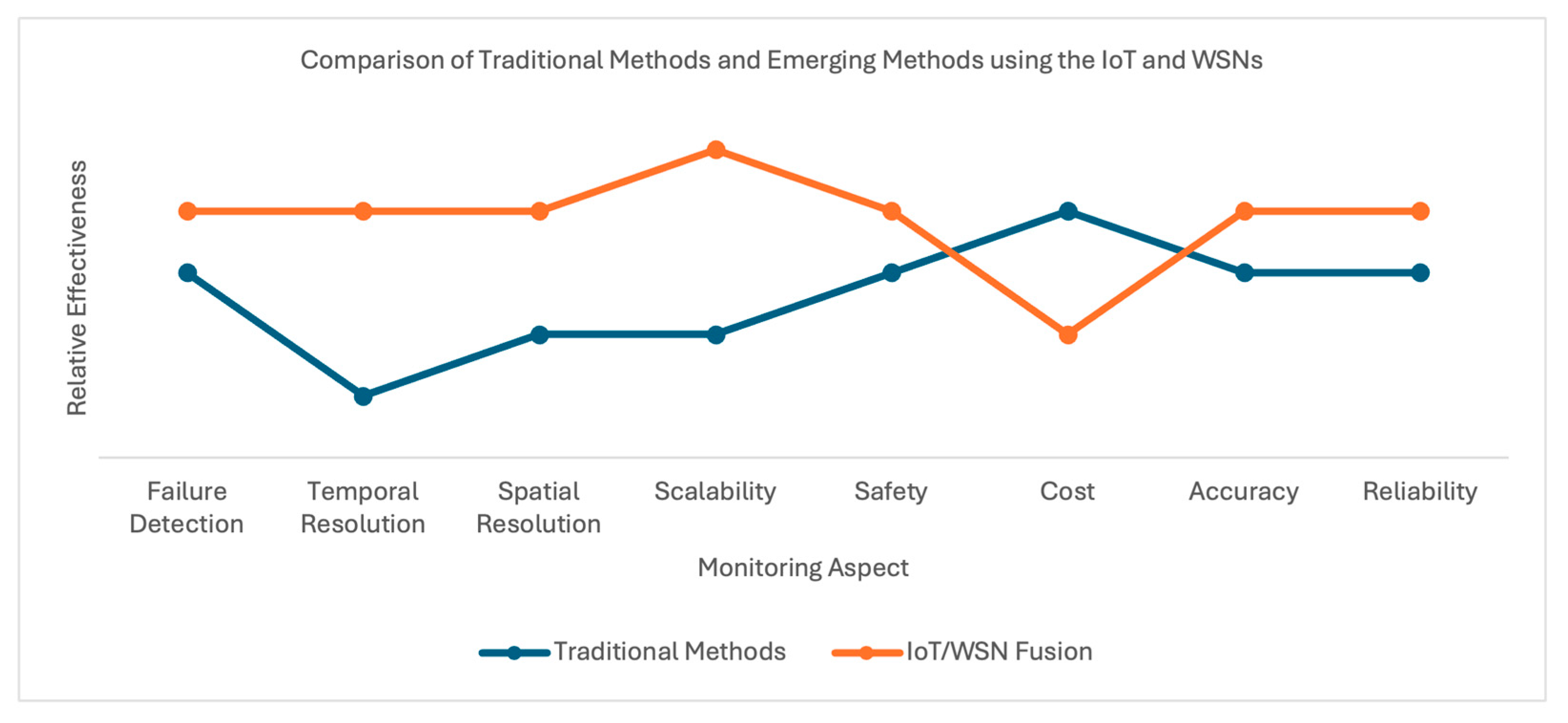4. Discussion
4.1. Key Findings: Traditional Open-Pit Slope Stability Monitoring Methods
This systematic review examined a comprehensive collection of slope stability monitoring methods used in open-pit mining, with a focus on their accuracy, spatial coverage, and practical limitations. The findings reveal that significant trade-offs exist between key performance dimensions, as illustrated in
Figure 14. Consequently, no single monitoring technique can be considered a universal or ‘gold standard’ solution, and, instead, the effectiveness of each method is highly context dependent, shaped by the specific geotechnical, environmental, and operational conditions of a given site.
4.1.1. Measurement Accuracy and Spatial Coverage
The results indicate that the trade-off between measurement accuracy and spatial coverage is, perhaps, the most polarizing difference between remote sensing and in situ monitoring. In situ monitoring methods, such as TDR and extensometers, provide a high degree of measurement accuracy by directly quantifying local strain, stress, and displacement within slopes [
4,
48,
49,
52,
53,
56]. However, their reliance on point-based measurements results in limited spatial coverage, impacting their ability to provide a holistic evaluation of overall slope stability.
In contrast, remote sensing methods, such as satellite-based radar and geodetic surveying, offer enhanced spatial coverage, enabling the detection of slope instabilities across vast areas [
20,
23,
28,
30,
33,
35,
36,
43,
57]. This comes at a detriment to measurement precision, however, as these methods are highly susceptible to environmental interference, due to the indirect nature of the data acquisition process used [
25,
33]. This trend is further demonstrated by methods using UAV-borne digital photogrammetry and LiDAR, which, despite providing good spatial coverage, are constrained due to the inherent limitations associated with data interpolation [
32,
39,
40,
47]. However, this is only broadly the case, as the review findings suggest that some remote sensing methods, such as ground-based radar and TLS, can achieve a balance between accuracy and coverage due to their fixed installation, allowing for slope stability coverage over moderately large areas [
19,
21,
32]. For this reason, it can broadly be surmised that remote sensing covers larger areas, but may have lower precision, while in situ monitoring provides high-precision, localized open-pit slope stability monitoring.
4.1.2. Temporal Resolution and Real-Time Monitoring
The relationship between the temporal resolution of slope stability monitoring methods and their real-time monitoring capabilities are a pertinent example of the compromises that can arise due to the underlying technologies associated with each monitoring technique. The most prominent example of this is the low temporal resolution of satellite-based radar, which can vary from several days to weeks, due to the infrequency of satellite passes used to acquire SAR spatial images. For this reason, D-InSAR and PS-InSAR are unsuitable for real-time, continuous open-pit slope stability monitoring, due to the underlying limitations of the InSAR technique and its dependence on satellite revisit times [
20,
23,
24,
28,
34,
35,
36,
42,
43].
Contrary to this, in situ monitoring methods have unanimously high temporal resolutions, with sensors capable of continuous, near real-time data acquisition, due to their high sampling rates [
51,
55,
56,
57,
58,
59]. Despite the temporal limitations of satellite-based radar, other remote sensing methods demonstrate enhanced real-time monitoring capabilities, depending on the sensing technologies used. Ground-based radar and geodetic surveying provide real-time subsidence monitoring, due to their use of high-frequency sensing instrumentation [
19,
21,
26,
28,
37,
41,
57]. UAV-borne digital photogrammetry and LiDAR, laser scanning, and thermal imaging all provide frequent, yet periodic, slope stability monitoring, due to the need for data post-processing [
26,
45,
46], achieving a balance between the temporal resolution and monitoring frequency. While the ability of remote sensing methods to provide continuous slope stability monitoring varies from method to method, as shown in
Figure 15, it is broadly evident that in situ techniques are better equipped for real-time data acquisition and monitoring, due to the inherently high temporal capabilities of their sensors.
4.1.3. Operational Complexity and Measurement Accuracy
The results suggest that the operational complexity and installation requirements of the monitoring methods are closely related to their overall effectiveness. The primary implication of this is that more accurate techniques are typically more costly due to the specialized infrastructure and maintenance associated with their implementation and operation [
55,
58,
59], and this increased complexity impacts their accessibility, as evidenced by the shift in the industry towards open-source stability monitoring frameworks [
30,
43,
44]. This relationship is most distinct across the in situ monitoring methods, which require specialized sensor installation within deep boreholes, allowing for precise, localized monitoring in predetermined failure zones [
55,
58,
59].
These methods involve time-consuming and laborious installation, maintenance, and recalibration procedures [
56]; however, their measurement accuracy and ability to capture sub-surface slope deformations justify their continued use in open-pit mining applications, despite their dwindling appearance in contemporary research (see
Figure 5 and
Table 7). Conversely, remote sensing methods provide a compromise between operational flexibility and monitoring efficacy due to their non-intrusive and cost-effective deployability. Both satellite-based radar and UAV-borne digital photogrammetry and LiDAR provide broad spatial coverage with minimal installation effort, making them well-suited for monitoring large slopes. However, this ease of deployment comes at the cost of measurement precision, as these remote sensing methods rely on indirect measurements and data interpolation, making them more susceptible to the effects of environmental interference [
20,
23,
24,
26,
28,
30,
31,
33,
35,
36,
43]. Alternatively, stationary or fixed sensing equipment, such as ground-based radar and TLS, offer superior measurement accuracy, albeit at a detriment to operational complexity [
11,
12,
13,
18,
19,
21,
22,
32].
4.1.4. Environmental Limitations
The harsh environments found across many of the world’s open-pit mines can severely undermine many of the most common slope stability monitoring methods available, impacting both data quality and measurement accuracy. Remote sensing methods, such as digital photogrammetry, ground-based radar, geodetic surveying, laser scanning, and thermal imaging, all rely on clear atmospheric conditions and unobstructed visibility to accurately document surface-level slope displacements. Cloud coverage, rain, and dust can degrade image quality and impact signal propagation, introducing noise and artifacts that reduce measurement accuracy [
11,
12,
14,
27,
28,
37,
47]. Additionally, remote sensing methods require a direct LoS to the target area, making them less effective in areas with dense vegetation, wherein obstructions can impact data acquisition and lead to unreliable results [
25,
33]. In contrast, in situ monitoring methods, like TDR, are less affected by environmental factors, given that they are properly installed, maintained, and recalibrated as needed. This is attributed to their use of durable materials, such as fiber optic cables, which are embedded deep within the sub-surface level of open-pit slopes [
58,
59].
4.1.5. Economic Considerations
The cost effectiveness of slope stability monitoring methods is broadly influenced by the balance between the initial investment costs associated with technology procurement and installation, long-term operational and maintenance expenses, and the overall risk mitigation benefits. Remote sensing methods exhibit inherent variability in their initial investment costs, due to the nature of the technology and sensors used. UAV-borne sensing using digital photogrammetry or LiDAR is considerably more economical than conventional laser scanning, geodetic surveying, and ground-based radar, due to its use of consumer-grade drones and digital cameras [
24,
26,
31]. Satellite-based radar is similarly inexpensive due to the lack of infrastructural investment required by mine operators, who can, instead, tap into vast repositories of imaging data that are freely available via online databases [
30].
The primary economic benefits associated with the use of remote sensing methodologies lie in their ability to reduce the need for manual inspections, minimizing personnel exposure to hazardous areas, while covering wide slope areas with minimal deployment efforts, yielding cost savings in the long term [
26,
30]. Despite the lower per unit cost of in situ monitoring methods using TDR, extensometers, piezometers, and inclinometers, their reliance on drilling boreholes and regular maintenance results in higher cumulative operational costs over time, particularly in large-scale mines where extensive monitoring is required [
55,
58,
59]. The choice of monitoring method is, therefore, often the product of a myriad of factors, such as budget constraints, mine lifespan, and operational priorities. Remote sensing, broadly, provides a more cost-effective solution for large-scale, low-maintenance monitoring, while in situ methods remain the most accurate means for quantifying slope displacements in high-risk failure zones.
4.1.6. Suitability for Different Mine Conditions
The effectiveness of slope monitoring methods is heavily influenced by site-specific conditions, such as mine depth and visibility, slope geology, and external operational factors, such as the frequency of blasting. For deep pits with limited satellite visibility, geodetic surveying using technologies such as GPS can be impacted by the restricted LoS to satellites, degrading signal propagation and affecting measurement efficacy [
14,
15,
20]. In such instances, ground-based radar and laser scanning provide enhanced monitoring capabilities by offering continuous, surface-level observations that are independent of any satellite constraints [
21,
37,
41]. However, UAV-borne sensing using digital photogrammetry and LiDAR surpasses these approaches due to its unparalleled operational flexibility, allowing for remote maneuverability across vast terrains, unconstrained by elevation limitations [
26].
The unique geology of each slope presents another challenge, as surface monitoring alone may not be sufficient to detect significant internal deformations, such as highly fractured rock masses. In these scenarios, in situ methods such as TDR and extensometers are more suitable, as they provide direct measurements of internal strain and shear deformation within the rock mass [
55,
58]. In active open-pit environments, frequent blasting is a common occurrence and, for this reason, the monitoring methods in use must account for the probability of rapid slope deformation. Ground-based radar and high-frequency geodetic surveying using TSs are particularly effective in these circumstances, due to their ability to provide real-time measurements and capture minute slope displacements, with high precision [
19,
26,
50], with methods such as satellite-based radar being ineffective due to the limited temporal resolution [
20,
23,
24,
28,
34,
35,
36,
42,
43]. In situ sensors also provide effective slope stability monitoring due to their real-time sensing capabilities, as per
Table 11 and
Table 12, given that they are equipped with wireless networking technologies for remote and automated data collection.
4.1.7. Scalability and Long-Term Viability
Open-pit mines are inherently large and expansive, with the long-term viability of slope stability monitoring methods depending, in part, on their ability to scale efficiently and effectively, all while maintaining consistent accuracy and reliability. Remote sensing methods are, predominantly, well-suited for large-scale slope stability monitoring, as discussed in
Section 4.1.1, with the exception of digital photogrammetry and thermal imaging.
Despite this, UAV-borne sensing, in particular, is highly scalable for periodic inspections, as it allows for rapid deployment over large areas, without the need for extensive infrastructure, due to its operational flexibility [
26]. Its scalability is, however, impacted by the inherent limitations associated with contemporary drone technology, such as limited battery life and payload capacity restrictions, impacting its continuous monitoring capabilities and long-term viability [
24]. Traditional in situ monitoring techniques, while offering high accuracy, can be logistically challenging to the scale of large or complex mine sites. Geotechnical instruments, such as TDR, piezometers, extensometers, and inclinometers, for instance, require extensive installation within boreholes and are limited to predetermined areas of interest, reducing their overall operational flexibility and, therefore, their scalability [
55,
58,
59].
4.2. Key Findings: Emerging Technologies for Open-Pit Slope Stability Monitoring
The findings from this systematic review highlight the transformative implications of the use of emerging technologies, such as AI, ML, the IoT, and WSNs, in improving the accuracy, efficiency, and scalability of slope stability monitoring in open-pit mines. As discussed throughout
Section 4.1, traditional monitoring methods have inherent limitations and trade-offs need to be made; however, the results indicate that emerging technologies can remedy these challenges by improving failure detection, providing real-time monitoring, and digitizing and automating manual processes, as demonstrated in
Table 14.
4.2.1. The Role of Artificial Intelligence
Perhaps one of the most significant benefits of using emerging technologies for open-pit slope stability monitoring is their ability to enhance failure detection and provide predictive analytics. While visual inspection remains a widely used and reliable method for identifying early signs of slope instability [
54], it exposes personnel to hazardous environments and is inherently prone to subjectivity and human error, and, significantly, is unsuitable for high-risk or rapid failure zones [
56]. AI and ML techniques, particularly computer vision-based approaches, augment traditional methods by leveraging ML methods like CNNs to automate slope failure detection.
As demonstrated in [
46,
54], AI-driven image analysis can remotely detect surface deformations, such as tensile cracks, with high precision, serving as an effective early warning system. Unlike traditional monitoring methods, which primarily measure slope displacement or forces such as stress and strain, AI models using computer vision focus on identifying visual indicators of slope failure, such as cracking, scarping, or raveling. The benefit of this approach lies in its ability to empirically and objectively detect significant precursory indicators of slope failure [
1,
5,
6,
7,
8], which may be overlooked or missed during infrequent, manual site inspections. By providing continuous, automated detection, AI-driven models can reduce the need for personnel to conduct field inspections in hazardous conditions, thereby improving operational safety.
Despite these strengths, computer vision-based failure detection faces several challenges, akin to those seen across the other remote sensing methods. High computational demands, the risk of false positives due to complex terrains and environmental interference, and a dependence on large, high-quality datasets for ML model training, all impact its practical implementation [
46]. Similar to digital photogrammetry and thermal imaging, AI-driven image analysis is also restricted by LoS limitations and, therefore, has a fairly localized spatial resolution. For this reason, AI-driven methods are most effective when used as complementary tools alongside traditional monitoring techniques, due to their inability to cover vast areas effectively in typical site conditions.
4.2.2. Integrated Monitoring Using the IoT and WSNs
The integration of the IoT and WSNs into geotechnical monitoring systems augments the scalability, flexibility, and responsiveness of traditional monitoring approaches. By deploying low-power wireless sensor nodes that capture and transmit physical data, such as stress, strain, or pressure, to cloud-based platforms, these systems enable real-time data acquisition, automated processing, and centralized data management [
59], essentially providing iterative benefits to in situ solutions. This distributed networking architecture allows for broad spatial coverage and supports continuous monitoring across expansive and often hazardous environments, as demonstrated in [
48,
50,
52].
Unlike conventional monitoring methods, which often face trade-offs between temporal resolution, spatial coverage, operational safety, and cost, as discussed throughout
Section 4.1, the fusion of the IoT and WSNs presents a comprehensive framework, with minimal compromises. As shown in
Figure 16, this approach excels across all key performance attributes in that it is scalable, cost effective, accurate, and supports continuous remote monitoring.
Furthermore, the integration of AI and edge computing within IoT frameworks enables real-time failure detection, advanced predictive analytics, and early risk mitigation strategies, enhancing both operational safety and decision making. This synergy allows for proactive slope management that can outperform traditional systems in terms of both responsiveness and precision [
59].
The two primary limitations of IoT and WSN adoption within large-scale mining operations are associated with the inherent, underlying restrictions of the respective technologies. The remote nature of wireless sensor nodes presents power consumption challenges, and the lack of protocol standardization across IoT networks introduces data security and interoperability issues [
52,
59]. Despite these constraints, it is clear that the fusion of the IoT and WSNs serves as a transformative and complementary advancement in the field of open-pit slope stability monitoring.
4.3. Future Research Directions
In light of these findings,
Table 15 presents a comprehensive evaluation of all the open-pit slope stability monitoring methods discussed in this review, collectively contrasting their strengths and weaknesses to identify potential gaps for future research. Accordingly, the following discussion focuses on these gaps, distilling them into clear, structured, future research directions.
4.3.1. Suggestion: Improve Monitoring Accuracy
Slope monitoring accuracy is a significant driver of effective operational safety in open-pit mining [
1,
2,
3,
4]. While most methods perform well in regard to capturing even the most minute slope displacements, notable limitations impact image-based techniques, such as digital photogrammetry and computer vision, particularly in challenging environmental conditions, postulating the need for further investigation.
The efficacy of digital photogrammetry is constrained by two predominant gaps, as highlighted by [
26,
27,
47], namely: reduced effectiveness in shaded or heavily vegetated areas, and reduced DEM accuracy due to data interpolation. To address the first gap, HDR imaging technologies should be explored for open-pit mining applications, as they have demonstrated improved shadow detail preservation in other domains, including agriculture [
61]. Regarding DEM accuracy, the integration of multi-sensor data extracted from in situ sources can be used to further enhance output precision, as evidenced by [
62], while deep learning methods can be explored to mitigate interpolation artifacts and improve DEM fidelity [
63].
Similarly, computer vision-based image analysis is also impacted by two principal limitations, in that its hazard detection accuracy is reduced in complex environments, and its object recognition capabilities are dependent on rigorously trained ML models that use high-quality datasets [
46,
54]. To address these issues, other ML models or algorithms should be explored, as analogous studies have demonstrated the effectiveness of various model optimization techniques in enhancing object detection accuracy, particularly in domains such as complex industrial construction environments [
64]. Furthermore, the difficulty associated with obtaining high-quality datasets for ML model training may be circumvented by exploring the applicability of GenAI for producing synthetic datasets [
65], particularly in the context of hazardous open-pit mines, where accessibility might be limited.
4.3.2. Suggestion: Enhance Spatial Coverage
Comprehensive spatial coverage is essential for providing holistic insights into overall slope stability, given the particularly complex geomechanics of vast open pits [
54].
In situ methods, fundamentally, face limitations in this regard due to their point-based, localized nature [
4,
48,
49,
52,
53,
56]. In contrast, remote sensing techniques typically excel in this regard as they offer a superior LoS [
19,
21,
32], with the exception of image-based approaches, such as digital photogrammetry and computer vision [
26,
46], which are tempered due to their underlying data collection methodologies. To overcome the spatial limitations inherent to in situ techniques, such as TDR, extensometers, inclinometers, and piezometers, future research efforts should investigate the retrofitting of traditional in situ monitoring frameworks with WSN capabilities and distributed sensor nodes, as described by [
48,
50,
59], to achieve increased spatial granularity, while also facilitating real-time, autonomous data collection.
The spatial performance of image-based remote sensing methods can be enhanced by leveraging context-aware sensing frameworks, guided by key geotechnical parameters. Specifically, incorporating ground control elements, such as TARPs and RMC criteria, into deployment and data interpretation strategies [
66] for autonomous UAVs could optimize monitoring frequency, thereby improving spatial coverage in high-risk areas. These context-aware sensing frameworks, which have been shown to greatly enhance the efficacy of computer vision-based image analysis in other domains [
67,
68], would allow monitoring systems to adapt dynamically to geotechnical risk profiles, enhancing overall slope coverage and maximizing monitoring efficiency.
4.3.3. Suggestion: Improve Temporal Resolution and Real-Time Monitoring
The effectiveness of any slope stability monitoring method is largely determined by its ability to provide advanced notice of incipient slope failure. Accordingly, temporal resolution, defined by the frequency of data acquisition, is a key performance metric, as systems capable of continuous or near real-time monitoring enable more proactive risk mitigation and timely intervention [
1,
4,
54]. Despite this, popular remote sensing methods, such as satellite-based radar and digital photogrammetry [
20,
23,
24,
26,
28,
34,
35,
36,
42,
43], as well as emerging technologies, such as computer vision-based image analysis [
46], provide unsatisfactory performance across this criterion, necessitating the requirement for further research.
The periodic and infrequent nature of SAR acquisitions is a limiting factor for both D-InSAR and PS-InSAR, restricting its ability to function effectively in volatile and evolving landscapes, such as open-pit mines [
33,
36]. For this reason, future research should explore the development of context-aware monitoring frameworks that integrate geotechnical parameters, such as slope angle, excavation rates, and ground control elements, to dynamically prioritize monitoring frequency and sensor deployment. These frameworks could enhance the temporal resolution through coordinated, integrated sensing strategies that complement satellite observations with ground-based sensors or UAV-based monitoring during satellite pass intervals.
The temporal resolution of digital photogrammetry is principally constrained by the high computational demands of data processing, particularly for 3D models and point cloud generation [
26,
45]. This issue is further compounded when coupled with ML-based computer vision techniques [
46,
54], which typically require significant Graphics Processing Unit (GPU) resources. However, advancements in edge computing have demonstrated the feasibility of performing such computationally intensive tasks in near real time, as shown in analogous domains like powerline inspection [
69]. Similarly, recent studies in autonomous UAV navigation and mapping [
70] have highlighted the benefits of offloading processing tasks to edge nodes to significantly improve responsiveness and data throughput.
To overcome the temporal limitations associated with conventional computer vision models, future research should investigate more efficient algorithms, such as YOLO, or lightweight, bespoke models designed for resource-constrained environments. When deployed in conjunction with edge AI on UAV platforms, these solutions could facilitate real-time hazard detection and adaptive monitoring in critical areas. This integrated approach has shown promise in comparable applications, such as autonomous road object detection on mine haul ramps, and presents a viable path toward improving the temporal resolution in open-pit slope stability monitoring systems [
71].
4.3.4. Suggestion: Address Environmental Limitations
Environmental conditions, such as adverse weather, can significantly impact the reliability and effectiveness of remote sensing and in situ slope monitoring technologies.
This trend is most evident across remote sensing methods, particularly those reliant on optical and radar imaging, wherein the results indicated that the impacts of dust, rain, and cloud cover could lead to signal attenuation and degraded image quality [
11,
12,
14,
27,
28,
37,
47]. For this reason, future research should investigate the suitability of redundant monitoring frameworks that leverage complementary sensor technologies capable of operating under varying environmental conditions. Such redundancy, in tandem with context-aware sensing, would ensure continuity in data acquisition during weather-induced disruptions, by, potentially, combining radar-based systems with rugged in situ sensors, thereby offering auxiliary monitoring to augment the overall reliability of the mine’s monitoring efforts.
While in situ monitoring systems, such as extensometers, inclinometers, and piezometers are inherently designed to operate under extreme conditions, they are, nonetheless, susceptible to degradation over time, leading to issues such as sensor drift and damage [
72]. For this reason, to improve system durability, future research should investigate fiber optic technologies, which are resistant to EMI and environmental degradation, as demonstrated in analogous contexts, such as landslide monitoring [
73].
4.3.5. Suggestion: Improve Economic Viability and Scalability
High equipment and ongoing maintenance costs pose significant limitations for various slope stability monitoring methods. Remote sensing technologies, including ground-based radar, thermal imaging, and laser scanning, along with in situ tools, such as TDR, extensometers, piezometers, and inclinometers, typically require substantial initial capital investment, are labor intensive to install and operate, and demand long-term maintenance, especially at scale [
24,
26,
55,
58,
59]. To address these financial barriers, future research should explore the viability of low-cost, modular sensors, such as those discussed in
Section 3.3.4. Despite the preliminary nature of these studies, advanced sensors like IMUs have been shown to provide a promising, cost-effective alternative to traditional in situ methods, due to their capacity to maintain acceptable accuracy and reliability [
59]. For this reason, similar technologies should be examined for their applicability to open-pit slope stability monitoring.
Aside from equipment costs, the challenge of scaling these methods across large, geotechnically complex mine sites remains a significant gap in the research. This limitation is most evident in regard to in situ methods, which are inherently localized and require substantial infrastructure [
55,
58,
59]. When implemented over extensive areas, the cumulative costs of installation and maintenance can rise quickly, hindering their feasibility for broad deployment across vast slope regions. To address this issue, future research should explore the use of IoT-enabled WSNs, as mentioned in
Section 3.5.2, utilizing low-power sensor nodes and long-range, efficient networking protocols like LoRa. Their successful implementation in fields such as landslide monitoring and environmental hazard detection [
74,
75] showcases their potential to facilitate cost-effective, large-scale deployments in open-pit mining.
4.4. Limitations of This Review
While this systematic review followed a structured research methodology and presented a comprehensive analysis of prominent open-pit slope stability monitoring methods, it is evident that there is a noticeable bias toward certain technologies, particularly remote sensing methods, such as satellite-based radar and UAV-borne sensing. This trend likely reflects a topical bias within the available body of the literature, which may overrepresent novel approaches, potentially skewing the review’s results. As a result, more traditional methods using in situ sensors, such as piezometers, inclinometers, and extensometers, may appear elusive and antiquated. Although this does not constitute a methodological flaw in the review itself, it introduces a research focus bias that may influence comparative assessments between traditional and emerging methods. More broadly, this limitation clearly delineates the lack of contemporary research covering in situ methods, once more supporting this review’s recommendations regarding the integration of the IoT and WSN technologies into traditional slope monitoring frameworks.
We also acknowledge that the inaccessibility of several studies during the full-text screening stage may have introduced a risk of selection bias, despite extensive efforts to obtain these articles. However, we believe that the thematic analysis of the included studies reflects consistent patterns and key findings across a diverse range of sources, suggesting that the overall trends identified in this review are robust. While we cannot entirely rule out the potential for bias, we do not expect that the exclusion of these inaccessible studies would significantly alter the conclusions drawn in this review.
Another limitation of this review lies in its exclusive focus on slope stability monitoring methods, deliberately excluding studies related to slope design, modeling, and stability analysis. In addition to this, our review does not consider health and safety aspects associated with asset tracking and monitoring. While this scoping decision allowed for analytical depth, it also constrained the breadth of the findings, particularly regarding integrated risk management practices. This limitation is especially relevant in the context of
Section 4.3.2 and
Section 4.3.3, which explore opportunities for context-aware sensing and real-time hazard detection, both of which benefit from holistic integration with geotechnical design and modeling data.
In addition, this review concentrated solely on monitoring applications within the context of open-pit mining, excluding analogous domains such as TSFs, embankments, and landslides. Although this focus was intended to ensure contextual relevance, it may have led to the exclusion of valuable insights, given that these applications often employ similar instrumentation, sensors, and monitoring approaches.
Lastly, several of the emerging methods identified, such as AI-based computer vision and IoT-enabled WSNs, are still in the nascent stages of application to open-pit mining. Consequently, their validation is often limited to controlled or simulated laboratory environments, which creates a significant data gap concerning their large-scale deployment, reliability, and long-term effectiveness.
5. Conclusions
This systematic review has examined, analyzed, and summarized 49 studies on slope stability monitoring methods in open-pit mining, comparing remote sensing and in situ technologies, while identifying emerging trends, such as AI-driven computer vision and IoT-enabled WSNs.
The findings reveal that remote sensing technologies constitute the bulk of contemporary research, focusing on advanced modalities like InSAR and LiDAR, while exploring the use of UAVs to generate DEMs, using digital photogrammetry techniques. These methods are broadly accurate, precise, and effective at detecting and monitoring indicators of incipient slope failure, namely, geological displacement and visual signals like scarping, raveling, and cracking. In situ methods, conversely, are far less common in state-of-the-art literature. Despite this, the review results indicate that reliable geotechnical instruments, like TDR, extensometers, piezometers, and inclinometers, are unanimously praised for their effectiveness in tracking and quantifying sub-surface slope displacement trends, despite their rudimentary operating principles and methodologies. Emerging technologies, such as AI, ML, the IoT, and WSNs, act as a mediator between the old and the new, providing enhanced predictive monitoring capabilities and continuous real-time stability monitoring.
Through comparative analyses, the findings suggest that no single method is universally optimal, as each exhibits trade-offs between key performance attributes, such as measurement accuracy, spatial coverage, temporal resolution, operational complexity, and cost. While traditional methods, such as remote sensing and in situ monitoring, remain highly effective in certain domains, their limitations, particularly in regard to scalability, automation, and adaptability, underscore the value of integrating emerging technologies.
Further to this, the review also identified several prominent research gaps, particularly in the areas of real-time monitoring, economic viability, and adaptability to complex geotechnical and environmental conditions. These limitations served as the basis for the stipulation of a detailed set of future research directions, focused on improving accuracy through sensor fusion, enhancing spatial and temporal coverage via distributed sensor networks built on ground control elements, and reducing operational constraints through the use of modular, low-cost equipment.
Overall, the findings of this review highlight that the future of open-pit slope stability monitoring lies in the implementation of hybrid frameworks, leveraging the strengths of both traditional and emerging technologies, such as AI. By pursuing interdisciplinary research across geotechnical and electrical engineering and data science, the mining industry can push towards smarter, safer, and more efficient slope stability monitoring solutions, to ensure that every mine worker goes home safely after their shift.
